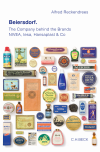Zusammenfassung
Everyone knows NIVEA. But only a few people are familiar with the Hamburg-based Company that created the "crème de la crème" and other successful Brands. The Beiersdorf story began in 1882. The firm lost its international business in two world wars and during the Nazi period it was exposed to anti-Semitic attacks. Beiersdorf had to start from scratch twice, and yet today it is a global player. Here for the first time, Alfred Reckendrees tells the fascinating story based on comprehensive archive material. He describes the economic challenges and political conflicts that the key actors had to overcome, and presents the Company strategies and reorientations, which are closely interwoven with Germany’s multifaceted history.
Today, you can find Beiersdorf Brands in every household. They include NIVEA, Hansaplast, 8x4, Eucerin, and La Prairie; also tesa, the adhesives specialist, belongs to Beiersdorf. Until the 1990s, the Company produced medicines and dressings as well. It all started in 1882 with a new plaster developed by pharmacist Paul Beiersdorf. Later, Oscar Troplowitz turned the small factory into a Brand Company with international operations. However, the US business, which generated most of the firm’s profit, was confiscated during the First World War. After the war, Beiersdorf had to build up its international business again from scratch. In 1933, the executive board and shareholders protected the “Jewish” Company against anti-Semitic attacks by means of “self-Aryanization.” Beiersdorf survived the Nazi regime; it could even take advantage of the economic opportunities it offered. After the Second World War, the Company lost its international business for the second time. It was not until 1997 that Beiersdorf regained control of all the trademarks worldwide.
- 6–15 Introduction 6–15
- 340–399 Appendix 340–399
- 400–401 Copyright 400–401

